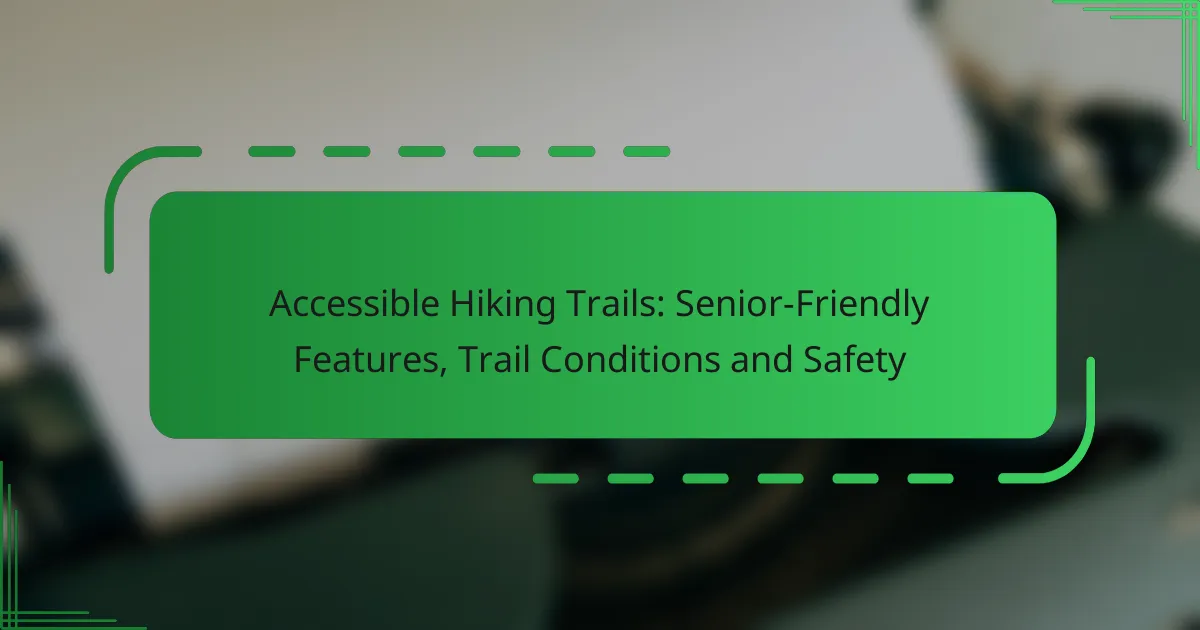Accessible hiking trails for seniors are designed with smooth surfaces and gentle inclines, providing a safe and enjoyable way to experience nature. Key features such as wide paths, rest areas, and accessible parking enhance both accessibility and safety, making it easier for older adults to explore the outdoors. Additionally, trail conditions, including maintenance and surface types, play a crucial role in ensuring a positive hiking experience for seniors.

What are the best accessible hiking trails for seniors in the US?
The best accessible hiking trails for seniors in the US offer smooth surfaces, gentle inclines, and amenities like benches and rest areas. These trails are designed to accommodate varying mobility levels, ensuring a safe and enjoyable experience in nature.
Great Smoky Mountains National Park
Great Smoky Mountains National Park features several accessible trails, including the Sugarlands Valley Nature Trail. This paved, flat path is about a mile long and provides scenic views of the surrounding forest. It is ideal for seniors looking for a leisurely stroll with minimal elevation changes.
Additionally, the park offers accessible restrooms and parking areas, enhancing convenience for visitors. Always check trail conditions before visiting, as weather can affect accessibility.
Acadia National Park
Acadia National Park is known for its accessible carriage roads, which are wide and well-maintained. The Jordan Pond Path is a popular choice, offering a flat, 3.3-mile loop with beautiful views of the Bubbles mountains. This trail is suitable for seniors seeking a peaceful hike with plenty of opportunities for photography.
Facilities such as accessible parking and restrooms are available throughout the park, making it easier for seniors to plan their visit. Be mindful of seasonal changes that may impact trail conditions.
Yosemite National Park
Yosemite National Park provides several accessible trails, including the Lower Yosemite Fall Trail. This short, paved trail is approximately one mile round trip and offers stunning views of the waterfall. It is perfect for seniors who want to experience the park’s beauty without strenuous hiking.
The park also has accessible shuttle services and visitor centers, ensuring seniors can navigate the area comfortably. Always check for any trail updates or accessibility changes before your trip.
Shenandoah National Park
Shenandoah National Park features the Stony Man Trail, a short, accessible path leading to a viewpoint with breathtaking vistas. The trail is less than a mile long and has a gentle incline, making it manageable for seniors. The park’s accessibility features include designated parking and rest areas along the trails.
Plan your visit during weekdays or off-peak seasons for a quieter experience, and be aware of weather conditions that may affect trail accessibility.
Mount Rainier National Park
Mount Rainier National Park offers the Trail of the Shadows, an accessible loop trail that showcases the park’s diverse ecosystems. This trail is about a mile long and features a mix of paved and gravel surfaces, making it suitable for seniors. Interpretive signs along the route provide educational insights about the area.
The park provides accessible facilities, including parking and restrooms, to enhance the experience for senior visitors. Always verify trail conditions and accessibility options before heading out, as they can vary with the seasons.

What senior-friendly features should I look for in hiking trails?
When selecting hiking trails for seniors, look for features that enhance accessibility and safety. Key elements include wide paths, gentle slopes, adequate rest areas, and accessible parking facilities.
Wide paths and gentle slopes
Wide paths allow for easier navigation, especially for those using mobility aids like walkers or canes. Trails with gentle slopes reduce the physical strain on seniors, making the hiking experience more enjoyable and less daunting.
Consider trails that have a width of at least 1.2 meters (4 feet) and a grade that does not exceed 5-10%. This ensures that most seniors can traverse the path comfortably without excessive effort.
Rest areas and benches
Rest areas equipped with benches are crucial for seniors who may need to take breaks during their hike. These spots provide opportunities to rest, hydrate, and enjoy the surroundings without feeling rushed.
Look for trails that have benches placed at regular intervals, ideally every 500 meters (about a third of a mile). This allows for manageable segments of hiking, making the overall experience more pleasant.
Accessible parking and facilities
Accessible parking is essential for seniors, ensuring they can easily reach the trailhead without long walks from distant parking lots. Look for designated accessible parking spaces that are close to the entrance of the trail.
Additionally, check for accessible restrooms and facilities along the trail. These amenities can significantly enhance the hiking experience, providing comfort and convenience for seniors.

How do trail conditions affect senior hikers?
Trail conditions significantly impact senior hikers by influencing their safety and overall hiking experience. Factors such as weather, maintenance, and surface types can determine how accessible and safe a trail is for older adults.
Impact of weather on trail safety
Weather conditions can dramatically alter trail safety for seniors. Rain can create slippery surfaces, while snow and ice can make trails hazardous. It’s essential for senior hikers to check weather forecasts before heading out and to avoid hiking during adverse conditions.
Additionally, extreme temperatures can pose risks. High heat can lead to dehydration, while cold weather can increase the likelihood of slips and falls. Seniors should dress appropriately and stay hydrated, adjusting their plans based on the weather.
Trail maintenance and accessibility
Regular trail maintenance is crucial for ensuring that hiking paths remain safe and accessible for seniors. Well-maintained trails typically have clear signage, stable footing, and minimal obstacles, which are vital for older hikers. Trails that are poorly maintained can have overgrown vegetation, loose rocks, or fallen branches that can pose risks.
When selecting a trail, seniors should look for those that are known for good maintenance practices. Local hiking clubs or park services often provide information about trail conditions and maintenance schedules.
Surface types and traction
The type of surface on a hiking trail can greatly affect traction and stability for senior hikers. Smooth, packed dirt or gravel trails are generally easier to navigate than rocky or uneven surfaces. Trails with a consistent surface allow for better footing and reduce the risk of falls.
Seniors should consider using hiking poles for added stability on uneven terrain. Additionally, wearing appropriate footwear with good grip can enhance safety. Trails with surfaces designed for accessibility, such as boardwalks or paved paths, are ideal for older adults seeking safer hiking options.

What safety tips should seniors consider while hiking?
Seniors should prioritize safety by preparing adequately for hiking trips. Key considerations include staying hydrated, using proper equipment for stability, and hiking with a companion to enhance safety and enjoyment.
Staying hydrated and nourished
Hydration is crucial for seniors while hiking, as dehydration can lead to fatigue and dizziness. Carry at least 1 liter of water for every two hours of hiking, and consider electrolyte-rich snacks like nuts or energy bars to maintain energy levels.
Plan your hikes during cooler parts of the day to minimize fluid loss. Always check the weather forecast and adjust your hydration strategy accordingly, especially in warmer conditions.
Using trekking poles for stability
Trekking poles can significantly enhance stability and reduce strain on joints while hiking. They provide additional support on uneven terrain, helping to prevent falls and injuries.
When using trekking poles, adjust them to the appropriate height, typically at elbow level when standing. Practice using them on flat ground before hitting the trails to build confidence and ensure proper technique.
Hiking with a buddy system
Hiking with a buddy is a vital safety measure for seniors. Having a companion ensures that help is available in case of an emergency, and it can also make the experience more enjoyable.
Choose a hiking partner who shares similar fitness levels and hiking interests. Always inform someone about your hiking plans, including the trail and expected return time, to enhance safety further.

What are the prerequisites for hiking with seniors?
Hiking with seniors requires careful planning and consideration of their physical capabilities and safety needs. Key prerequisites include assessing their fitness level, choosing appropriate trails, and ensuring they have the right gear and support.
Senior-Friendly Features
When selecting hiking trails for seniors, look for features that enhance accessibility and comfort. These may include well-maintained paths, gentle slopes, and resting areas. Trails with handrails, benches, and clear signage can significantly improve the hiking experience for older adults.
Consider trails that are shorter in distance, ideally under 5 kilometers, to accommodate varying endurance levels. Many parks offer designated senior-friendly trails that prioritize ease of navigation and safety.
Trail Conditions
Before heading out, check the trail conditions to ensure they are suitable for seniors. Look for information on surface types, such as gravel or paved paths, which are easier to navigate than rocky or uneven terrain. Weather conditions can also impact trail safety, so avoid hiking during extreme heat or inclement weather.
Local park services often provide updates on trail conditions, including any closures or maintenance work. It’s wise to consult these resources prior to your hike to ensure a safe experience.
Safety Considerations
Safety is paramount when hiking with seniors. Always carry a first aid kit and ensure that seniors have necessary medications on hand. Hydration is crucial, so encourage regular water breaks, especially on warmer days.
It’s advisable to hike in groups and maintain a steady pace that accommodates all participants. Establish a communication plan in case anyone needs assistance, and consider using walking aids if necessary, such as trekking poles or walking sticks.



